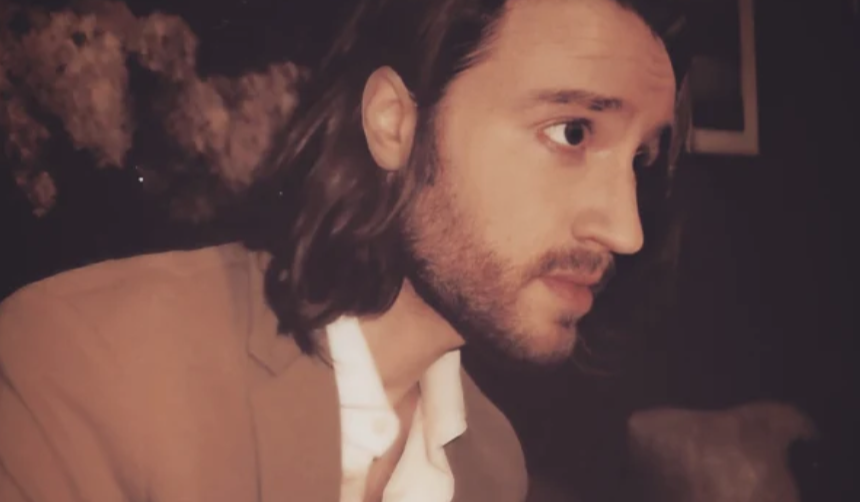
We recently had the pleasure of meeting with Eric Terino, an artist who makes music that mixes a timeless quality with a sense of forward thinking. He’s just released his outstanding new album “Innovations of Grave Perversity”, which blessed our ears with his passionate artistic universe. It is a truly intriguing body of work that seduces with deep thought and contemplative musings.
“Innovations of Grave Perversity” is a clever mix of soft-rock tinted with cinematic soundscapes that we wouldn’t dare label with conventional language, as it sends you on a new kind of musical journey.
Eric Terino challenges convention throughout this 8-track opus all the while captivating us with his melancholic poetry. We enter into “Innovations of Grave Perversity” with ‘Felt’, an emotionally-driven ballad built on magnificent chords and featuring a relaxed vocal performance that gives you a drifting cosmic feeling.
Terino serves his unique signature all throughout the project, yet still manages to surprise us along the way. With tracks like “An Augury Of Hope” or “Body Gets Stoned”, he explores classic sonorities and melodic arrangements worthy of the greats. Songs like these give us a feeling of soaring above beautiful landscapes and into seas of strange thought.
“Innovations of Grave Perversity” closes with the splendid “I Didn’t Live There”, a song that could serve as the musical definition of triumph. Once again, quality meets with creativity to offer an otherworldly moment rocked by violins, bewitching soundscapes, and comforting vocals. Eric Terino leaves you with hope, loads of emotion, and proves that originality still exists. He is one of these artists who honor the traditions of music history while still being able to create new worlds.
We were totally amazed to listen to Eric Terino’s magical album and it was only right that we have a little chat with him, as we were curious about his inspiration and creative process. Rendez-vous below to read it; and in the meantime, dive into the strange beautiful world of “Innovations of Grave Perversity”.
Innovations of Grave Perversity is a very intriguing title for a record. Can you explain where that came from?
Well, I don’t want to give too much away because I think it can mean different things to different people, or even different things at different points in your life. But I will say it originated as a sort of long-handed way of saying “changes”. It was the title of the record pretty much from its conception, and along the road of writing the album, it found its way into a song called “Invocations”, which is about bereavement and how we manage the death of loved ones as we move further away from the impact of those losses. I always felt “Invocations” was the heart of the record, which is why it’s nestled in the middle of the tracklist and also why the phrase felt so appropriate to that particular song. It’s about building a space for memories without anger or resentment, and that concept was definitely a change in my life. Personally, it has to do with a shift in mindset, a transition from a place of despondency to a realm of potential for joy. That for me, has been a very significant change.
Speaking of changes, this album calls in new instrumental flavors that we haven’t heard much of in your previous recordings, including tastes of horns, stringed orchestral arrangements, ambient textures and even a musical saw. What led you to those discoveries as you were building these recordings?
Yes! That’s another reason why the phrase felt like such a fitting title for this project. It wasn’t just a shift thematically, but also sonically. I’d made two LPs prior to the Innovations… album, which I’d recorded entirely by myself, and both were pretty drastically different from one another. It’s always important to me to try my best to keep evolving and exploring new musical territories. So every time I enter into making a record the importance of creating something notably different is at the forefront of my mind.
My first album (Mountains of Nothing In Love) was a very minimalist/lo-fi/punk-spirited sort of affair, and one heavily influenced by rage and being right at the impact of trauma. For my sophomore record (Champagne and Childhood Hunger) I was interested in playing with unconventional song structures and working with manipulated sounds. That whole record used small electronic instrumentation that was then distorted or amplified to create a surreal almost shoegaze-y feeling. Those songs were also deeply impacted by the trauma I’d experienced a couple of years prior when I made Mountains…, I still had a lot to process before I could feel any semblance of hope.
So when I began the process of putting together Innovations of Grave Perversity I instinctively felt that this project was about opening myself up and making connections to a world I’d once thought to be so cold and unwelcoming. I naturally seemed to feel things lifting, a sense of peace that told me it wasn’t right to close myself off anymore, artistically or in my personal life. So, not only did I decide that this record would be comprised of completely natural sounds without any electronic influence, but also that I needed to reach out to other musicians so we could build this thing together. It was truly one of the most fulfilling experiences I’ve ever had, and I’m so grateful to all the incredible musicians and friends who helped bring these songs to life.
It’s interesting that you mention the impact personal trauma has had on your records, as your album artwork gives a nod to art history and painting styles often associated with artists who have lived particularly dark or complicated lives. Do you feel a connection to those sorts of artists? And do you “paint” into your music in the same way others might create works on a canvas?
Definitely, there’s an intentional parallel being drawn between the album art and the work of those artists you mentioned. Someone once described me as having “a colorful life”, which always makes me laugh. I don’t really think of myself that way, but I guess it’s true. I’ve certainly not had a conventional sort of existence, and it’s been extremely painful at times. So I definitely do connect with that dark complicated realm of expression.
The idea behind the Innovations… artwork was that there’s this figure emerging from the shadows and slowly entering into the light. That cover portrait depicts someone who’s finally surfacing on the other side of an incredibly dark and troubled time with a renewed sense of possibility. But It all plays into itself, which is why making records is so rewarding for me. There are so many different mediums involved outside of just writing and recording the songs. You get to work with painting, photography, film, design, the list goes on and on. I wholeheartedly believe in the album as a viable medium for a work of art. In my mind, there’s no difference between Fuseli’s Nightmare and PJ Harvey’s Rid of Me, or The Scream and Marianne Faithfull’s Broken English. It’s all drawn from the same well, they’re just using different methods of presentation.
That sense of the record being a complete work unto itself really comes through. These days it’s becoming de rigueur for listeners to consume music one track at a time. So what led you to create a full-length concept album instead of opting to release standalone singles or individual ideas?
I think it’s really important that there are people out there upholding the tradition of the album. Which isn’t to say I don’t think there’s merit in standalone singles and working within that framework. But I think at this point in the development of our society the attention span has just been so greatly reduced. It’s a natural reaction to what’s around us, everything is so easily scrolled past and everyone’s trying to grab your attention in literally 2 or 3 seconds. Just the other night I was reading an interview with Yoko Ono from nearly 60 years ago, where she was explaining how she felt that nobody had the patience or attention span to read extensive literature anymore and that’s why her book Grapefruit consisted of these brief almost haiku-like passages spread out over seas of white space. So this has been going on for a long time, which gives me a sense of hope really.
I don’t believe that the album format will ever be “outdated”. There are so many people out there who still want to spend time with a long book or immerse themselves in the world an album creates. It’s a magical thing, to have access to all these different worlds and to be able to spend time in them. I guess that’s the difference between “art” and “entertainment”, which isn’t to say those two worlds can’t or shouldn’t collide. I just find that for what I want to create, the best way to do that is by building a complete layered picture in the format of an album.
A sense of hope and growing optimism comes through as the songs progress on this record. Do you suppose that trend will continue as you keep writing and recording? Do you have a sense of how this album will carry you into future projects?
It’s so wonderful to hear that you can feel that! That truly was the intention. In a way, it is a proper “concept album”, where it begins in winter from a place of uncertainty and yearning for internal security, and transitions to the beginning of spring with a sense of restored faith and hope for the future. You spend the majority of the record-making your way through the winter, and it’s not until “An Augury of Hope” when things finally start to thaw. Then it’s followed by “Body Gets Stoned”, where if you listen closely you can actually hear field recordings of birds singing as they return for the dawn of spring. I tried to work a lot of small, almost subliminal things like that in there to carry you through that journey as you listen.
But yes, this is also the most autobiographical work I’ve ever made and it all comes from direct experience. I do feel I’m in the spring again, and I think making this record played a significant role in allowing that to happen. So now I do my best every day to keep the momentum going and to spread a positive light on everything I can. Who knows what the future holds, but I’ve no doubt that things will continue to evolve. Whether that means an eternal sense of optimism, I can’t say. I mean, it would be foolish to think it’s always going to be sunny. So I’m very curious to see where I find myself when it’s time to start working on another album. But today, I’m so pleased and proud of the work I’ve done on this record and the fact that I’ve made it to this point in my life’s journey. It’s been a strange and shifting path, but it’s brought me here, and for that, I am extremely grateful.
Follow Eric Terino on INSTAGRAM HERE

“Felt” is now in our Winter Mood Playlist :

